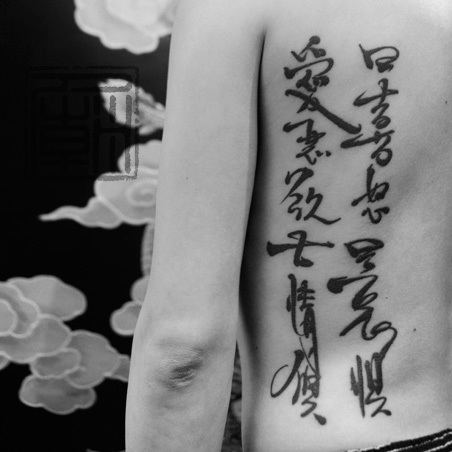 | ||
Chinese calligraphy tattoos are a form of tattooing and a style of calligraphy combined into one form of art. Originally, Chinese calligraphy and tattoos were combined to distinguish social class or tribes. Calligraphy started in Europe and Asia and then spread to other continents and countries. Today, Chinese calligraphy tattoos can be found worldwide and anyone is able to receive them. People who tend to get these tattoos are fond of this style of tattooing because of their perceived uniqueness.
Contents
Calligraphy
Calligraphy is a form of art related to writing. A pen, fine pointed object, or a brush can be used to draw symbols. Calligraphy originated in ancient Greece. There are many different forms and styles of calligraphy that have evolved over the centuries.
Styles
Calligraphy comprises many different permutations because different cultures and traditions influenced their styles. Classical, modern, and typography are three well known styles of calligraphy. Modern calligraphy is one of the most common out of the three styles, often displaying designs and art pieces. Modern calligraphy bears a resemblance to classical calligraphy, from which it is derived. In modern calligraphy it is hard to distinguish the letters because they are mostly illegible. Classical calligraphy is an older, more common style that people prefer to use. Typography is the art of designing proportionally spaced lettering arranged in the form of words, sentences, and blocks of text – also known as type.
Chinese calligraphy
Chinese calligraphy is the stylized, artistic writing of Chinese characters; the written form of Chinese that unites the languages spoken in China. Calligraphy is considered supreme among the visual arts in China and sets the standard for which Chinese painting is judged. Chinese calligraphy and painting are closely related. Each era of Chinese calligraphy has different styles and forms. Chinese calligraphy originated in ancient China around 4000 BC and is still used today. In ancient China, characters were painted on stones, steles, or bones and the brushstrokes were later carved out. Later on, calligraphy was written on paper or scrolls. Cursive, handwritten, and computer-generated are a few different styles of Chinese calligraphy that could be used on scrolls or paper. Nowadays, Chinese calligraphy can be painted on scrolls and paper or typed and printed off of computers. Handwritten was most common because it could be used on anything and it could be put anywhere. Traditionally, Chinese calligraphy is made using brushes, ink, paper, paperweights, and desk pads.
Brushes and strokes
In Chinese calligraphy, the order of the strokes is very important. Stroke order is important to Chinese calligraphy tattoos because it is a part of the history and it helps tattooists understand how to tattoo someone who wants Chinese calligraphy. Characters, which are the symbols used in calligraphy, should be written with the fewest hand movements and most strokes possible. This form promotes writing speed, accuracy, and readability to anyone who views it. Stroke order is normally taught at a young age because it aids in learning and memorization for students and it can help them in the future. Character order is also very important. Many characters have more than one correct stroke form or order when writing and the stroke orders are conservative in regarding etymology, character construction, character evolution, and tradition. However, stroke orders will vary depending on the script style being used. A person can either use cursive or regular script to write the Chinese characters. However, cursive is the preferred script because it shows stroke order more clearly and each stroke made by the writing tool is more visible.
Stroke order guidelines
Tattoos
Tattoos are made by inserting a needle with ink underneath the outer layer (the epidermis) and into the dermis layer of the skin to change the pigment. Tattooing has been around for many centuries and is believed to have started around 6000 BC on a South American mummy. Tattooing techniques have been dated back to the dawn of humankind, historians having found examples from the Neolithic era. When tattooing first began mostly men and people within tribes had tattoos, until about the late 1800s and early 1900s, when women started to receive tattoos. Men, women, and teens commonly get tattoos now, most commonly by way of an electric tattoo machine, which inserts ink into the skin via a single needle or a group of needles that are soldered onto a bar attached to an oscillating unit.
Styles
There are five types of tattoos: traumatic, amateur, professional, cosmetic, and medical. Chinese calligraphy tattoos may be amateur, professional, or cosmetic. Amateur and professional tattoos are the most common because they were used in tribes, where tattoos originated. However, cosmetic tattoos are becoming more popular because many people want to change or enhance their features. Amateur and professional tattoos are mostly used to express emotions or how a person felt about someone they cared deeply about. Many tribe members had tattoos to identify whom they were, in social class, and if they belonged to someone. Both medical and traumatic tattoos are not as common as the other types and usually do not make use of Chinese calligraphy. Medical tattoos are mostly used on patients who have a skin pigmentation disorder. Traumatic tattoos are caused by substances, such as asphalt, rubbing into the skin and ultimately changing the color of the skin.
Chinese textual tattoos
Chinese textual tattoos are unique and also very common today. The possession of tattoos is meant to express the concept of being in control of one's body. People also receive these tattoos because they find them aesthetically pleasing as well as empowering. Many more women than men are receiving textual tattoos, wanting to give the impression of total ownership and control over their own bodies. In pre-modern China, textual tattoos were also used as a punishment for criminals. Criminals would get textual tattoos on their cheeks and foreheads of the crime that they committed and would therefore have their crime on display for the rest of their lives.
